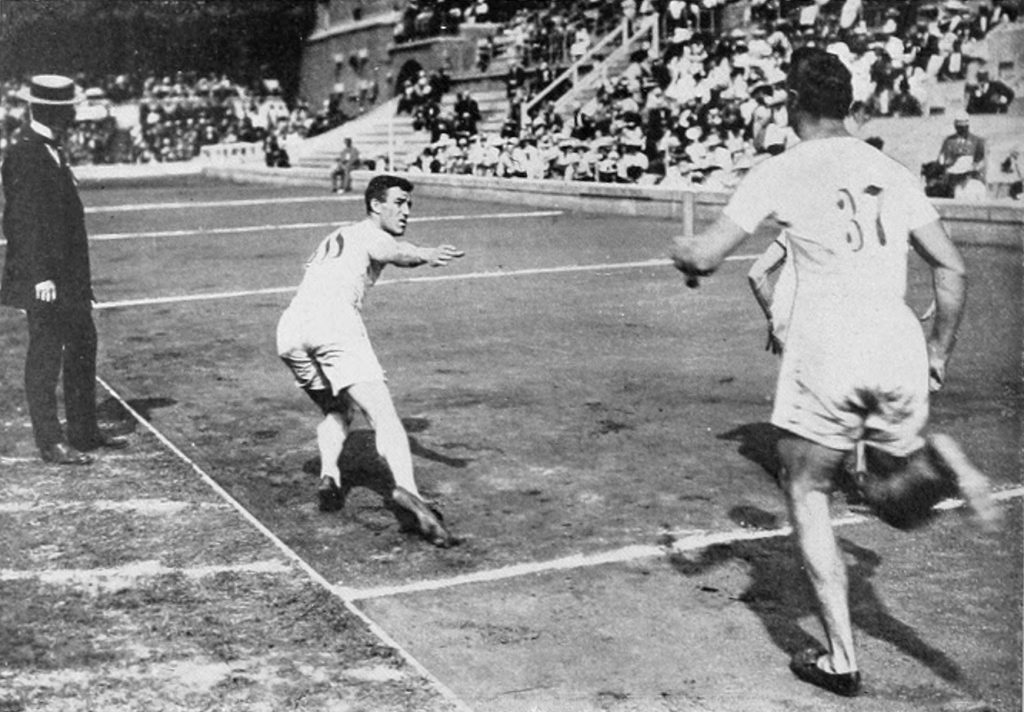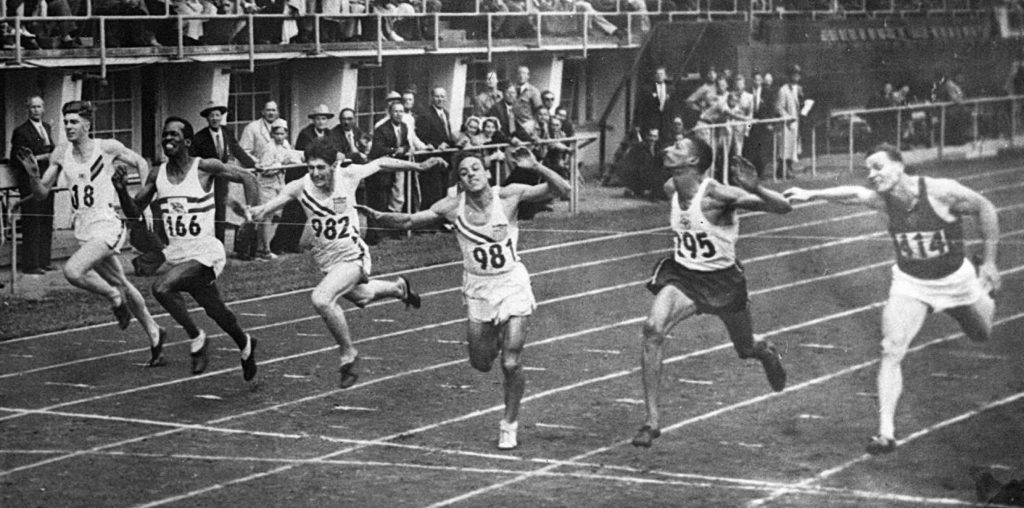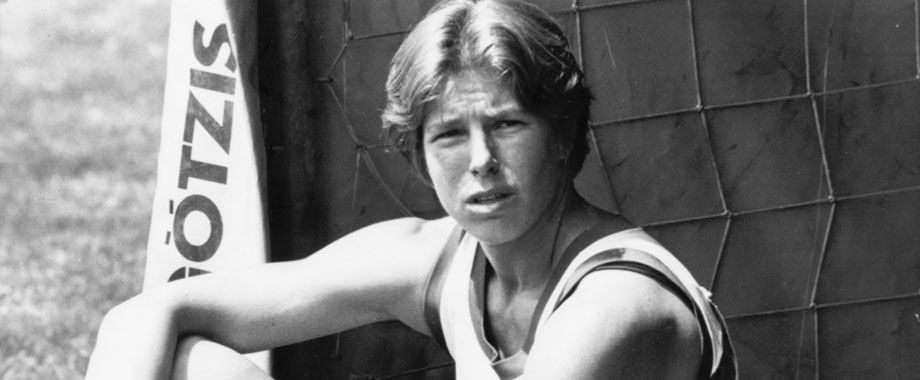This Day in Track & Field–July 21
RelatedPosts
1908–At the London Olympics, “Peerless Mel” Sheppard won the 800 meters with a World Record time of 1:52.8. Not sure why, but Sheppard continued on to 880-yards (1:54.0). It was one of three gold medals for Hall of Famer Sheppard, who had earlier won the 1500 (7-14) with an Olympic Record-equaling time of 4:03.6 and later anchored the winning sprint medley (7-25). He won gold in the 4×400 relay and silver in the 800 at the 1912 Olympics. For many years the “Mel Sheppard 600y” was one of the featured events at the Millrose Games (revived in recent years at various distances).

Results: https://en.wikipedia.org/wiki/Athletics_at_the_1908_Summer_Olympics
http://en.wikipedia.org/wiki/Mel_Sheppard

1926— 14-year old Viola Edwards became the first female to clear 5-feet when she high-jumped 5-1/2 (reported elsewhere as 5-1/8) in Chicago.
http://tinyurl.com/ViolaEdwards
1952—Lindy Remigino emerged as the winner of the Men’s 100-meters in Helsinki in the closest sprint finish in Olympic history, with the top 4 men all clocking 10.4. Off to an early lead, Remigino, despite starting his lean 20-meters before the finish, was able to hold off Jamaica’s Herb McKenley, the world record holder in the 440-yard dash, Great Britain’s McDonald Bailey, and U.S. teammate Dean Smith (U.S. Trials winner Art Bragg went out in the semis with an injury).
The finish was so close that officials took 20 minutes before announcing the official results. It wasn’t until the scoreboard started spelling his name in first place that Remigino, who had offered his congratulations to McKenley after the race, knew he had won and a dejected McKenley knew he hadn’t.
Few would have picked the Manhattan College junior as the winner in any pre-Olympic prediction contests. He finished 5th at the NCAA Championships to barely qualify for the U.S. Trials (top 6 advanced), and didn’t make the AAU final.
However, Remigino, who would win a 2nd gold medal as a member of the winning 4×100 relay, disagreed with those who called him the “Cinderella Kid”. “That really wasn’t right,” he said. “I was second in the U.S. Olympic Trials. If you are the second-fastest American qualifier, it’s not a surprise if you do well at the Olympics.” Before the Games began, the U.S. team flew to Finland, and he trained three times a day. “I knew I was going to do well,” he said. “I was beating everybody there. I was the first guy down the straightaway. I didn’t lose one gun start at practice.”

Remigino, who passed away in 2018 at the age of 87, followed his Olympic win with a successful European tour and wound up ranked #1 in the world by Track and Field News. He remained active in the sport as a highly successful coach at Hartford Public High School in Connecticut (his alma mater) for more than 50 years, and was the long-time meet director of the Hartford Inv., once one of the top prep meets on the East Coast.
When asked a few years ago if he ever showed the footage of his Olympic win to his family, he said with a smile, “Every night!”. His son Mike was one of the top preps in the country in the 800 in 1987, running a best of 1:49.94.
The seeds for his Olympic dreams were planted four years earlier. “Track & Field News was first published in 1948,” I’d read it, seen all the names and times. My favorites were Mel Patton and Harrison Dillard. I admired them so much. Guess who passed me the baton in the relay in 1952?” (Harrison Dillard). “So, yes, I dreamed of going to the Olympics in 1948. But the reality was I thought I’d be working in a box shop, making cardboard boxes, on Albany Avenue, because my family didn’t have the money for college.”
4th-placer Dean Smith, who won a gold medal in the 4×100, went on to have a successful career as a Hollywood stuntman. Hie memoir, “Cowboy Stuntman: From Olympic Gold to the Silver Screen”, was published in April, 2013.
http://www.nytimes.com/2013/03/31/us/cowboy-stuntman-dean-smith-writes-a-memoir.html?_r=1&
http://www.amazon.com/Cowboy-Stuntman-Olympic-Silver-Screen/dp/0896727890
Remigino wasn’t the only American to win gold on this day. Parry O’Brien hadn’t yet become the dominant thrower of his era, but his first-round toss of 57-1 ½ (17.41) held up to give him the first of his two Olympic gold medals in the Shot Put (he also won in 1956). U.S. Trials winner Darrow Hooper almost stole the gold medal from O’Brien with his final put of 57-3/4 (17.39), which was good enough to win the silver medal. World record holder Jim Fuchs, hampered by ankle and wrist injuries, made it a U.S. sweep with his best of 55-11 ¾ (17.06). And Charlie Moore, the former Cornell Athletic Director, won the 400-hurdles in 50.8 to match the Olympic Record he set in his quarter-final race.
Medalists/Results
http://en.wikipedia.org/wiki/Athletics_at_the_1952_Summer_Olympics
Remigino:
Race Video:
Gary Cohen Interview: http://www.garycohenrunning.com/Interviews/Remigino.aspx
http://www.nbcconnecticut.com/news/sports/Connecticut-Runner-Was-Fastest-Man-Alive-147371295.html
http://www.courant.com/sports/high-schools/hc-sp-riley-column-lindy-0720-story.html
Hall of Fame Bio: https://www.usatf.org/athlete-bios/lindy-remigino
1961—In the first-ever dual meet between Great Britain and the U.S., Max Truex finished 3rd in the 3-mile behind Brits Gordon Pirie (13:16.4) and Bruce Tulloh (13;16.8) and set an American Record of 13:21.0
Willye White long-jumped 21-1/4 (6.44) to set her 3rd American Record in five days. She had previously jumped 21-0 (6.40) in Moscow on July 16 and 21-3/8 (6.41) in Karlsruhe, Germany, on July 17.
No AR in the men’s 440y, but it was the race of the 2-day meet, with Ulis Williams (46.3) holding off GB’s Adrian Metclafe (46.4) for the win, while his U.S. teammate, Adolph Plummer (46.8), edged Robbie Brightwell (46.8) for 3rd place. Great Britain got a taste of revenge the next day (July 22) by beating the U.S. in the Mile Relay (3:07.0-3:07.4).
(From T&F News)
1962—Hal Connolly set a World Record of 231-10 (70.67) in the Hammer Throw on the first day of the USA-Soviet Union dual meet at Stanford.
WR Progression: http://en.wikipedia.org/wiki/Men’s_hammer_throw_world_record_progression
1963–Valery Brumel set his 6th (and final) World Record in the High Jump, clearing 7-5 ¾ (2.28) at the 4th edition of the highly popular USA-Soviet dual meet series in Moscow (7-20/21).
Bob Hayes won the 100-meters and thought he had anchored the winning 4×100 relay, but officials ruled that he received the baton too soon from 3rd-leg Paul Drayton, who had earlier won the 200.
WR Progression: http://en.wikipedia.org/wiki/Men’s_high_jump_world_record_progression
Tribute Video: https://www.youtube.com/watch?v=9r0hdHV95sU
Sports Illustrated Vault: https://vault.si.com/vault/1963/02/04/the-big-jump-a-siberian-champion-tells-his-story
1984—Mike Tully cleared 19-1 (5.82) at the Prefontaine Classic in Eugene to better his own month-old American Record (19-3/4 [5.81) in the Pole Vault. Results
There was another major meet on the West Coast on this day, with Johnny Gray running 1:14.16 in the seldom-run 600-meters at the Sacramento Summer Games to break Lee Evans’ 16-year old American Record of 1:14.3. Gray would set the current AR of 1:12.81 in 1986.
Between them, the two meets, held less than two weeks before T&F action began at the L.A. Olympics, drew almost 30,000 fans (Pre-13,600, Sacramento-16,000).
1984—Jane Frederick, who missed making the Olympic team in the Heptathlon after no-heighting in the High Jump at the U.S. Trials, achieved some redemption by scoring 6611 points (1971 tables/6678-1985 tables) in Potsdam, East Germany, to regain the American Record from Jackie Joyner, who had scored 6520 (6579) points at the Trials. Frederick would improve the Record to 6714 (6803) in Talence, France, in September
East Germany’s Marita Koch won the Women’s 200-Meters in 21.71 to equal her 5-year old World Record.
Hall of Fame Bio(Frederick/2007): https://www.usatf.org/athlete-bios/jane-frederick























